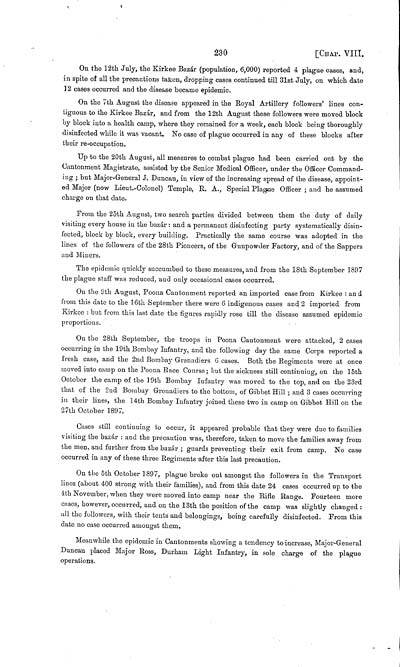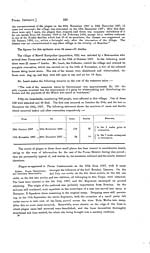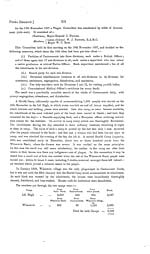Medicine - Disease > Bombay plague: being a history of the progress of plague in the Bombay presidency from September 1896 to June 1899
(299) Page 230
Download files
Individual page:
Thumbnail gallery: Grid view | List view

230 [CHAP. VIII.
On the 12th July, the Kirkee Bazar (population, 6,000) reported 4, plague cases, and,
in spite of all the precautions taken, dropping cases continued till 31st July, on which date
12 cases occurred and the disease became epidemic.
On the 7th August the disease appeared in the Royal Artillery followers' lines con-
tiguous to the Kirkee Bazar, and from the 12th August these followers were moved block
by block into a health camp, where they remained for a week, each block being thoroughly
disinfected while it was vacant. No case of plague occurred in any of these blocks after
their re-occupation.
Up to the 20th August, all measures to combat plague had been carried out by the
Cantonment Magistrate, assisted by the Senior Medical Officer, under the Officer Command-
ing ; but Major-General J. Duncan, in view of the increasing spread of the disease, appoint-
ed Major (now Lieut.-Colonel) Temple, R. ?., Special Plague Officer ; and he assumed
charge on that date.
From the 25th August, two search parties divided between them the duty of daily
visiting every house in the bazr : and a permanent disinfecting party systematically disin-
fected, block by block, every building. Practically the sanie course was adopted in the
lines of the followers of the 28th Pioneers, of the Gunpowder Factory, and of the Sappers
and Miners.
The epidemic quickly succumbed to these measures, and from the 18th September 1897
the plague staff was reduced, and only occasional cases occurred.
On the 9th August, Poona Cantonment reported an imported case from Kirkee : and
from this date to the 16th September there were 6 indigenous cases and 2 imported from
Kirkee : but from this last date the figures rapidly rose till the disease assumed epidemic
proportions.
On the 28th September, the troops in Poona Cantonment were attacked, 2 cases
occurring in the 19th Bombay Infantry, and the following day the same Corps reported a
fresh case, and the 2nd Bombay Grenadiers 6 cases. Both the Regiments were at once
moved into camp on the Poona Race Course ; but the sickness still continuing, on the 15th
October the camp of the 19th Bombay Infantry was moved to the top, and on the 23rd
that of the 2nd Bombay Grenadiers to the bottom, of Gibbet Hill ; and 3 cases occurring
in their lines, the 14th Bombay Infantry joined these two in camp on Gibbet Hill on the
27th October 1897.
Cases still continuing to occur, it appeared probable that they were due to families
visiting the bazar : and the precaution was, therefore, taken to move the families away from
the men, and further from the bazar ; guards preventing their exit from camp. No case
occurred in any of these three Regiments after this last precaution.
On the 5th October 1897, plague broke out amongst the followers in the Transport
lines (about 400 strong with their families), and from this date 24 cases Occurred up to the
4th November, when they were moved into camp near the Rifle Range. Fourteen more
cases, however, occurred, and on the 13th the position of the camp was slightly changed :
all the followers, with their tents and belongings, being carefully disinfected. From this
date no case occurred amongst them.
Meanwhile the epidemic in Cantonments showing a tendency to increase, Major-General
Duncan placed Major Ross, Durham Light Infantry, in sole charge of the plague
operations.
On the 12th July, the Kirkee Bazar (population, 6,000) reported 4, plague cases, and,
in spite of all the precautions taken, dropping cases continued till 31st July, on which date
12 cases occurred and the disease became epidemic.
On the 7th August the disease appeared in the Royal Artillery followers' lines con-
tiguous to the Kirkee Bazar, and from the 12th August these followers were moved block
by block into a health camp, where they remained for a week, each block being thoroughly
disinfected while it was vacant. No case of plague occurred in any of these blocks after
their re-occupation.
Up to the 20th August, all measures to combat plague had been carried out by the
Cantonment Magistrate, assisted by the Senior Medical Officer, under the Officer Command-
ing ; but Major-General J. Duncan, in view of the increasing spread of the disease, appoint-
ed Major (now Lieut.-Colonel) Temple, R. ?., Special Plague Officer ; and he assumed
charge on that date.
From the 25th August, two search parties divided between them the duty of daily
visiting every house in the bazr : and a permanent disinfecting party systematically disin-
fected, block by block, every building. Practically the sanie course was adopted in the
lines of the followers of the 28th Pioneers, of the Gunpowder Factory, and of the Sappers
and Miners.
The epidemic quickly succumbed to these measures, and from the 18th September 1897
the plague staff was reduced, and only occasional cases occurred.
On the 9th August, Poona Cantonment reported an imported case from Kirkee : and
from this date to the 16th September there were 6 indigenous cases and 2 imported from
Kirkee : but from this last date the figures rapidly rose till the disease assumed epidemic
proportions.
On the 28th September, the troops in Poona Cantonment were attacked, 2 cases
occurring in the 19th Bombay Infantry, and the following day the same Corps reported a
fresh case, and the 2nd Bombay Grenadiers 6 cases. Both the Regiments were at once
moved into camp on the Poona Race Course ; but the sickness still continuing, on the 15th
October the camp of the 19th Bombay Infantry was moved to the top, and on the 23rd
that of the 2nd Bombay Grenadiers to the bottom, of Gibbet Hill ; and 3 cases occurring
in their lines, the 14th Bombay Infantry joined these two in camp on Gibbet Hill on the
27th October 1897.
Cases still continuing to occur, it appeared probable that they were due to families
visiting the bazar : and the precaution was, therefore, taken to move the families away from
the men, and further from the bazar ; guards preventing their exit from camp. No case
occurred in any of these three Regiments after this last precaution.
On the 5th October 1897, plague broke out amongst the followers in the Transport
lines (about 400 strong with their families), and from this date 24 cases Occurred up to the
4th November, when they were moved into camp near the Rifle Range. Fourteen more
cases, however, occurred, and on the 13th the position of the camp was slightly changed :
all the followers, with their tents and belongings, being carefully disinfected. From this
date no case occurred amongst them.
Meanwhile the epidemic in Cantonments showing a tendency to increase, Major-General
Duncan placed Major Ross, Durham Light Infantry, in sole charge of the plague
operations.
Set display mode to: Large image | Zoom image | Transcription
Images and transcriptions on this page, including medium image downloads, may be used under the Creative Commons Attribution 4.0 International Licence unless otherwise stated. ![]()
| India Papers > Medicine - Disease > Bombay plague: being a history of the progress of plague in the Bombay presidency from September 1896 to June 1899 > (299) Page 230 |
|---|
| Permanent URL | https://digital.nls.uk/74586566 |
|---|




